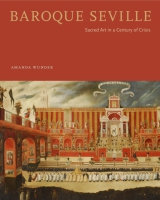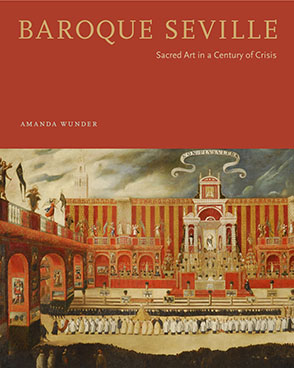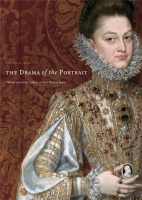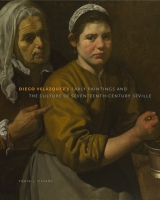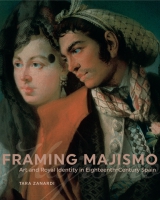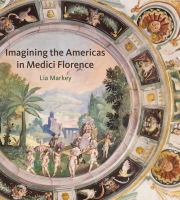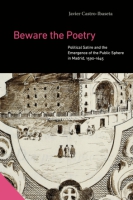Baroque Seville
Sacred Art in a Century of Crisis
Amanda Wunder
“Although one can find many studies devoted to specific Sevillian artists of the seventeenth century and to Spanish art and architecture of this period, the present work takes a unique approach.”
- Description
- Reviews
- Bio
- Table of Contents
- Sample Chapters
- Subjects
Amanda Wunder investigates the great public projects of sacred artwork that were originally conceived as medios divinos—divine solutions to the problems that plagued Seville. These commissions included new polychromed wooden sculptures and richly embroidered clothing for venerable old images, gilded altarpieces and monumental paintings for church interiors, elaborate ephemeral decorations and festival books by which to remember them, and the gut renovation or rebuilding of major churches that had stood for hundreds of years. Meant to revive the city spiritually, these works also had a profound real-world impact. Participation in the production of sacred artworks elevated the social standing of the artists who made them and the devout benefactors who commissioned them, and encouraged laypeople to rally around pious causes. Using a diverse range of textual and visual sources, Wunder provides a compelling look at the complex visual world of seventeenth-century Seville and the artistic collaborations that involved all levels of society in the attempt at its revitalization.
Vibrantly detailed and thoroughly researched, Baroque Seville is a fascinating account of Seville’s hard-won transformation into one of the foremost centers of Baroque art in Spain during a period of crisis.
“Although one can find many studies devoted to specific Sevillian artists of the seventeenth century and to Spanish art and architecture of this period, the present work takes a unique approach.”
“A penetrating and thoughtful historical study that considerably deepens our understanding of the city and the genesis of some of its most important works of sacred art.”
“A significant contribution that should appeal to scholars across disciplines. Art historians, historians, and literary scholars of the early modern Iberian and Atlantic world will find much to reflect on in this concise and elegantly written publication.”
“Amanda Wunder has brought Baroque Seville to life as never before. There is a sizable amount of literature on the subject, but none that synthesizes and integrates evidence from such an amazing variety of sources. Given the wide scope and the utterly lucid style of writing, this book can and should be read by all who are interested in the projection of faith that emanated from this most colorful of European cities.”
“In this insightful and original work, Amanda Wunder, through a series of revealing vignettes and case studies, magisterially shows how Sevillians, while mired in horrific economic, social, and environmental crises, chose appeals to the sacred as a way to secure the protection of Seville’s well-established saints and divine protectors. This is a profound, erudite reflection on the connections between art, wealth, and religion in Seville, and by implication in seventeenth-century Spain, in a time of crisis. A most wonderful book!”
“Wunder’s book is a well-written, tightly focused study of art and society in seventeenth-century Seville. It offers novel interpretations of major art and architectural monuments as well as lesser-known luxury objects and ephemeral festivals. Wunder’s attention to the process by which patrons—wealthy elites and common people, men and women—engaged with teams of artists forces a reconsideration of the efforts and intentions behind the making and meaning of art in the Baroque era.”
Amanda Wunder is Associate Professor of History at Lehman College and of Art History at the Graduate Center of the City University of New York.
Contents
List of Illustrations
Acknowledgments
Currency, Weights, and Measures
Introduction
1 The Art of Disillusionment: The Patronage of Mateo Vázquez de Leca
2 The Piety of Powerful Neighbors: The Renovation of Santa María la Blanca
3 A Temporary Triumph: The Seville Cathedral’s Festival for San Fernando
4 The Nobility of Charity: The Church and Hospital of the Santa Caridad
5 The Phoenix of Seville: Rebuilding the Church of San Salvador
Conclusion
Chronology
Notes
Bibliography
Index
Introduction
When news reached Seville in the winter of 1649 that plague had been spotted on the coast of Spain, the city council made the disastrous decision to keep the city gates open to commerce. Rumor had it that the plague was brought to Seville by a man from Cádiz who was lodging in a house near the Tower of Gold (Torre del Oro), next to the river (see the frontispiece map of Seville, with place-names mentioned in the text). Within two days of the man’s arrival, everyone in the house where he was lodging was dead. As the contagion spread inside the city, local authorities did what they could to contain it. Plague victims were quarantined in hospitals outside the city walls, and their contaminated clothes and possessions were destroyed in bonfires. The bodies of the dead were carted to mass graves on the outskirts of town, and aromatic herbs were burned in the streets to purify the air. Sevillians diligently applied these pragmatic secular measures—medios humanos (“human methods”), as they were known at the time—according to Diego Ortiz de Zúñiga (1633–1680). But they placed more trust in medios divinos (“divine methods”), the Sevillian chronicler explains, electing “to beg for clemency and placate divine justice.”
The medios divinos that Sevillians employed during the plague of 1649 included “prayers, rogations, acts of penitence,” and “processions of light and blood” with penitents carrying candles and flagellants whipping themselves. At the height of the plague, on June 26, 1649, Seville’s secular and religious authorities led a joint procession around the steps of the cathedral with a sacred sculpture, the Virgin of the Kings (Nuestra Señora de los Reyes) (fig. 1). After the procession, there was palpable relief from the plague, Ortiz de Zúñiga reports. Then, on July 2, the Cristo de San Agustín—a fourteenth-century sculpture of the crucified Christ that had a reputation for working miracles—was brought from the Augustinian monastery, outside the eastern city walls, to the cathedral, in the city center. A crowd of people followed the life-size Gothic crucifix through the streets “with sorrowful cries,” Ortiz de Zúñiga writes, in “a display of the greatest emotion and spiritual remorse.” After spending the night at the cathedral, the image of Christ was returned to the monastery of San Agustín the following day. From that point forward, the plague was in retreat. By the end of the month, the plague hospitals had been closed, and the elite citizens who had fled to the countryside had returned back home. When it was all over, approximately sixty thousand people—half of Seville’s population—had died. The Cristo de San Agustín was credited with ending the worst epidemic in the city’s history, thus confirming the sculpture’s reputation and affirming the efficacy of the medios divinos.
Early modern Europeans, Catholics and Protestants alike, routinely interpreted natural disasters as divine punishment and promoted religious action as the most effective solution. Cardinal Gabriele Paleotti advocated spiritual remedies when plague struck his bishopric of Bologna in 1575; the parliamentarian and diarist Sir John Oglander interpreted the rains, floods, and harvest failure that struck England in 1647 as divine punishment for the civil war. Six years after the plague of 1649, the Andalusian lawyer Francisco Salado Garcés published a book in which he promoted medios humanos for combating the disease but argued that divine methods should always be tried first, since “plague and contagion come to the world because of the sins of men, and they are the reason for it.” Prayers and processions were emergency measures to be undertaken in moments of crisis, but it would be infinitely better to avoid divine punishment in the first place. A city had recourse to different kinds of medios divinos in order to cultivate divine favor. Reforming immoral behavior was perhaps the most difficult. More feasible projects included building or decorating a church, promoting a local saint for beatification or canonization, and founding a new charitable institution. Such communal displays of devotion and good works were strategies for strengthening a city’s spiritual defenses.
Sevillians made a massive investment in long-term medios divinos in the troubled decades of the seventeenth century. Sculptors carved a fleet of new processional sculptures that painters brought to life with realistic flesh tones, while embroiderers and goldsmiths crafted opulent gowns and crowns for venerable old images like the Virgin of the Kings. Seville was turned into an open-air church for religious feast days and special celebrations when triumphal arches were erected in the streets and plazas, precious reliquaries and liturgical vessels were brought outdoors and displayed on temporary altars, and building facades were covered beneath rich fabrics, tapestries, and paintings (fig. 2). Seville’s most privileged citizens served the poor and needy at new charity hospitals that were attached to opulent churches. Between the 1660s and 1720s some thirty-two religious buildings—parish churches, monasteries and convents, and other sacred structures—were built, rebuilt, or renovated beyond recognition, and an even greater number of altarpieces and chapels were added to existing structures. Monumental paintings and gilded altarpieces adorned the walls of old and new churches, whose ceilings were covered with ornaments made from carved plaster (yesería). Imposing new church facades rose over the busiest streets and plazas in the city, while colorful tiled domes and bell towers redefined the skyline. The investment in medios divinos in the seventeenth century had a profound impact on the physical landscape and ritual practices of Seville and continues to define the city and its self-image to the present day.
With the proliferation of new religious buildings and the renovation of old ones, Seville became a giant construction site in the late seventeenth century. The Baroque aesthetic that was transforming cities all across Spain at this time left an especially strong imprint on urban development in Seville, where it found unique expression. The profusion of ornament, the mixture of medias, and the theatrical panache that are all characteristic of the Baroque interacted with Seville’s multilayered history, autochthonous building materials, and religious traditions to create a distinctive local variant of the style. The richness and splendor so typical of the arts in this era were a natural fit for the city that served as Europe’s gateway to New World treasure. Renowned for their conspicuous consumption at the height of Spain’s transatlantic trade in the sixteenth century, Sevillians would channel the secular splendor to which they had become accustomed into devotional art and architecture when their fortunes began to fade.
Nestled in a crook of the Guadalquivir River fifty-four miles inland from the Atlantic Ocean, Seville had a long history as an international port and commercial center that dated back to its founding by the Romans. During the city’s Islamic era (712–1248), such exotic goods were available that it was said, “If thou seekest for birds’ milk, by Allah thou shalt find it in Seville.” International trade continued to thrive in Seville after the Christian conquest of the city in 1248. The Guadalquivir bustled with ships traveling to Seville from Christian and Muslim lands—from Alexandria, Aragon, Catalonia, Ceuta, England, France, Genoa, Tangier, “and from many other places beyond the seas,” according to the late thirteenth-century General History of Spain. In the last decade of the fifteenth century, Seville was home to a thriving community of Genoese merchants who helped to finance Columbus’s maiden voyage across the Atlantic in 1492. The monarchs Isabella I and Ferdinand II (r. 1474–1516) rewarded Seville with a monopoly over Spain’s new colonial trade. All ships going to and from the Americas had to stop first in Seville, where the House of Trade (Casa de Contratación) was established in 1503.
Lope de Vega called Seville the “port and gateway to the Indies, through which it could be said that the universal sustenance of Spain enters twice a year.” The playwright was referring to the biannual sailings of the merchant ships in fleets (flotas), one that left Seville in August for Tierra Firme (Panama) and stopped in Cartagena and La Havana before returning in May or June, and another that sailed to New Spain (Mexico) in April and came back in July. The late sixteenth-century View of Seville attributed to the court painter Alonso Sánchez Coello depicts the activity in the area known as the Arenal, the sandy stretch of riverbank between the pontoon bridge linking Seville and Triana, on the left, and the thirteenth-century watchtower, the Tower of Gold, on the right (fig. 3). A pulley machine next to the tower was used to unload the boats and galleys that transported goods to the Arenal from the large galleons that survived the treacherous transatlantic crossing. In 1574 the Sevillian doctor Nicolás Monardes described the “incredible wealth” that came to Seville from the New World: gemstones, exotic animals and hides, valuable dyes, cotton, copper, sugar, gold, and silver—most of all silver—17,637 tons of which passed through Seville between 1503 and 1660 before flooding the European markets. Sevillians exchanged their own native produce and imports from the Indies with European cities such as Antwerp and Florence in return for tapestries, books, silks, gold thread, paintings, and other fine goods. The precious raw materials and luxury products that arrived at the Arenal were loaded onto ox-drawn carts and driven into the city.
New World treasure transformed Seville from a well-to-do regional capital into one of the largest, wealthiest, and most cosmopolitan cities in the early modern world. Merchants from all over Spain and Europe—most of all Flanders and Italy—flocked to Seville, and so did foreign artists and craftsmen, who were attracted by the opportunities that could be found there. Seville became a major center for the Atlantic slave trade, especially after the Spanish annexation of Portugal in 1580, and had the largest population of slaves in Spain. The total population of Seville doubled between 1500 and 1588 to reach an estimated 150,000, which made it one of the most populous cities in Europe at that time. Significantly smaller, Rome in 1580 had a population around 80,000, and Madrid’s was about 65,000 at the end of the sixteenth century. Seville’s population boom gave rise to a building boom in domestic and public architecture. Between 1561 and 1588 an estimated 2,456 new houses were built to accommodate the burgeoning populations of Seville and Triana, the neighborhood across the river where many shipbuilders and sailors lived.
During the sixteenth century medieval Seville became a modern city with urban planning ideas, building materials, architects and craftsmen imported from Italy. The monumental building projects of the sixteenth century were primarily secular in nature and used a classicizing vocabulary to communicate Seville’s newfound imperial status: a new town hall, a public park (the Alameda de Hércules), and the monolithic Lonja, which was built next door to the cathedral to house the Casa de Contratación. The gates in the ancient city wall were renovated in the form of triumphal arches, like the one that can be seen on the right-hand side of the city view attributed to Sánchez Coello (fig. 3). The gate, called the Postigo del Carbón after the coal that was sold in its vicinity, was refashioned as a triumphal arch adorned with shields and statues in 1566. When King Philip II (r. 1556–98) visited Seville in 1570, the unrenovated parts of the city along the king’s procession route were covered with temporary architecture and tapestries to reflect a unified vision of Seville as a “New Rome.” The city councilmen dressed in floor-length robes of purple velvet in imitation of ancient Roman senators to greet their monarch.
Seville was the most expensive city and the one with the highest standard of living in sixteenth-century Spain. By midcentury, working-class Sevillians owned luxury goods that used to belong exclusively to the upper classes, such as jewelry of precious metals and gemstones, and garments and household textiles made from sumptuous fabrics—damask, velvet, and taffeta—sometimes even trimmed with gold. Meanwhile, the upper classes acquired luxury goods in greater quantity and variety than ever before. The high demand for luxury goods in Seville supported a wide range of specialized local craft industries. Pearls alone required three different kinds of specialists to sort, pierce, and string them into necklaces. The arts of silversmithing and embroidery reached their apogee in Seville in the sixteenth century. Luxury goods were sold on the cathedral steps (Las Gradas), in the silk market (Alcaicería de la Seda), and in the shops on Calle Sierpes. Local historians like Luis de Peraza and Alonso Morgado proudly described Sevillians’ fine dress, magnificent palaces, quality craftsmanship, and luxury markets as evidence of their city’s greatness, while foreign visitors marveled at the treasures they saw average citizens wearing in the streets. Conspicuous consumption came to define Seville’s reputation and self-identity, both at home and abroad, in the sixteenth century.
Seville’s wealthy merchants were renowned for their ostentatious displays of luxury goods. Like their counterparts in Renaissance Florence and Venice, the merchants of Seville—a group that included many foreigners and families of Jewish origins (conversos)—sought to assimilate into the upper echelon of society by building splendid Renaissance palaces and filling them with sumptuous furnishings, artworks, and other precious objects. Social boundaries were fluid in sixteenth-century Spain, most of all in the cosmopolis of Seville, where wealthy newcomers married local noblewomen and positioned their sons among the local nobility by buying titles from the Spanish Crown and purchasing seats on the exclusive cathedral chapter and city council. This made Seville’s wealthy newcomers the legal equals of the old nobility, but they lacked the traditional signs of status in Spanish society—the proverbial “lance and ancient shield on a shelf” inherited from noble ancestors who had fought the Moor centuries before. Seville’s nouveau riche compensated with public displays of their wealth. In 1571 one sympathetic observer warned Seville’s “merchants with an appetite for nobility” to avoid ostentatious displays of property, servants, jewels, and other luxuries, for a merchant who was seen spending a lot would be suspected of cheating his customers. But successful merchants like Gaspar de Arguijo, a Canary Islander who settled in Seville around 1565, paid no heed to the warning. Having made a fortune in the slave trade, Arguijo amassed an impressive collection of urban and rural properties, including a palace in central Seville that he filled with treasures. His son, the poet Juan de Arguijo, inherited the family fortune in 1594, when his father died, and spent it all by 1608, when he lost the family palace to his creditors.
The story of Juan de Arguijo’s bankruptcy—the subject of gossip and fascination in his hometown—epitomized the city’s collective fall from fortune at the turn of the century. Seville’s problems began in the 1580s, when merchant galleons were conscripted for Philip II’s disastrous attempt to invade England; half the commercial fleet was destroyed with the Spanish Armada. Transatlantic crossings of the flotas ground to a halt between 1586 and 1589. Then the 1590s brought a combination of bad weather, harvest failures, and floods that left Seville’s population weak and susceptible to the plague that arrived in 1599. The plague was still active when a cathedral prebendary (racionero) named Francisco Porras de la Cámara (d. 1616) wrote a gloomy letter in 1600 to Grand Inquisitor Fernando Niño de Guevara, who was about to take office as archbishop of Seville (r. 1601–9). Porras warned the incoming archbishop that the situation in Seville was dire: “I regret to inform Your Grace that the calamities suffered by my city and your episcopacy are not only pestilences, sicknesses, shortages, and other needs and miseries, for in every way Seville is among the most lost and hopeless cities in all his majesty’s kingdom.” God was using the plague to punish Seville for its sins, Porras explained, comparing the disease to a torture device called the “scorpion” (alacrán)—a whip with barbed ends like a scorpion’s stingers that had been used to torture the early Christian martyrs. “I am very fearful that God’s punishments will not cease if we do not stop offending Him,” Porras wrote. He called upon Niño de Guevara to lead a complete spiritual and cultural reform in Seville in order to regain divine favor.
The situation in Seville only worsened over the rest of the century, as natural and man-made disasters barraged the city (see the chronology at the end of this book). Imports of American silver began to diminish after 1592 as the accessible ores at the top of the Cerro Rico (“rich mountain”) of Potosí (Bolivia) were depleted. Transatlantic traffic declined over the seventeenth century, such that the registered tonnage carried between Spain and its colonies fell by 90 percent. At the same time, the shallow bed of the Guadalquivir was shrinking, its sandbar growing, as the river filled with lost tonnage, sunken ships, and runoff from frequent floods. Seville experienced one of the worst floods in its history during the winter of 1626. Another flood, in March of 1649, cut the city off from food supplies and set the stage for the deadliest epidemic in the city’s history. At midcentury, the population of Seville was already down from a high of 150,000 to 125,000; the plague reduced that number by half, leaving Seville about where it had been back in 1492.
When the French diplomat François Bertaut visited Seville in 1659, ten years after the plague, he was unimpressed by what he saw. “Arriving in Seville, one cannot believe that it deserves the great reputation it has acquired,” he wrote. “It is on a large plain on the bank of the Guadalquivir River, which is not very large, and where there is a pontoon bridge that is very ugly. There are no longer ships, because they all go to Cádiz.” Seville had been losing trade to coastal Cádiz for decades before the Crown officially moved Spain’s transatlantic port there in 1680. It was a devastating blow to the city on the Guadalquivir. That same year, Seville was struck by an earthquake. More floods and famines followed in the 1690s. In his chronicle entry for the year 1700, Lorenzo Baptista de Zúñiga looked back at the era that had just come to a close and described it with apparent exhaustion as “the ill-fated century” (el siglo fatal).
Seville’s problems took place within the context of a general seventeenth-century crisis of national, continental, and even global proportions. Spain fell from its position of prominence abroad and was besieged by economic and political crises within its own shrinking borders. Historians have long debated the causes and chronology of Spain’s decline, and some scholarship has argued that the Spanish economy actually rebounded in the last decades of the seventeenth century. What is indisputable is that there was a profound sense in seventeenth-century Spain that something had gone terribly wrong. The term “decline” (declinación) began to appear around 1600 in the writings of political and economic reformers (arbitristas) like Martín González de Cellorigo, as John H. Elliott has pointed out. González de Cellorigo claimed that everything in Spain was in decline—population and productivity, agriculture and industry, manliness and morality—and he placed much of the blame on New World wealth. In addition to its deleterious effects on the Spanish economy, it was believed that easy money from the Americas was having a pernicious impact on the Spanish character by creating a society of idle men and rapacious women who consumed everything and produced nothing. In 1600 González de Cellorigo went so far as to claim that Spain would have been better off altogether without American treasure: “If all the gold and silver that the Spanish have found and continue to discover in the New World were to enter Spain, it would not make the country so rich, so powerful, as it would have been without it.” The sense of disillusionment expressed by González de Cellorigo would be exceptionally keen in Seville, as the epicenter of Spain’s colonial trade and the city that had been changed by New World wealth more than any other.
Across Spain, individuals and institutions in big cities and small villages turned to medios divinos in the seventeenth century. On the national level, the Castilian Cortes voted in 1617 to elevate Saint Teresa of Ávila to patron of Spain (alongside the traditional patron, Saint James, or Santiago), as a religious solution to the problems that were plaguing the Kingdom of Castile and the Spanish Crown. Locally, communities in the beleaguered diocese of Cuenca, in a bid to win the protection of the saints, built a large number of new rural shrines during a period of declining populations and resources between 1583 and 1654. Such investments in supernatural solutions to Spain’s problems were combined with pragmatic measures as part of an overall reform program. Medios divinos and medios humanos were complementary, not contradictory, as Baltasar Gracián explains in The Art of Worldly Wisdom (1647): “Human means must be sought as if there were no divine ones, and divine ones as if there were no human ones.”
According to Gracián’s maxim, equal effort should be put into medios divinos and medios humanos without privileging one over the other. But Seville’s local authorities were notoriously bad at the medios humanos. Sevillians accused their Crown-appointed royal governor (asistente) and city councilmen (veinticuatros) of negligence during the flood of 1626, when the men who were supposed to be guarding the city gates went home to sleep as the rising river waters broke through and flooded the city. In the aftermath of the flood, Seville’s master of public works, Andrés de Oviedo, proposed an ambitious plan to protect the city from future flooding by cleaning out the riverbed and digging canals. The damaged city walls were repaired, but none of Oviedo’s long-term solutions was carried out. His proposal to build a permanent replacement for the old pontoon bridge between Seville and Triana was not realized until the iron bridge named for Queen Isabella II was built in 1852. The Seville city council’s previously mentioned decision not to close the city gates in 1649 contributed to the enormous loss of life during the plague, according to Francisco Salado Garcés’s account. Local leaders in Cádiz, however, effectively quarantined their city and avoided the worst of the epidemic—a key factor in the rise of Cádiz to take Seville’s place in the second half of the century.
Inept in their handling of the medios humanos, Seville’s elites were remarkably conscientious when it came to the medios divinos. They showed great tenacity, spending decades pursuing the canonization of Fernando III and rebuilding the old church of San Salvador, to name two long-term religious projects. They invested enormous sums of money in religious art and architecture—sometimes on ephemeral decorations that lasted only a few days or weeks before they were destroyed. These magnificent public displays have been characterized as an authoritarian effort to preserve a conservative regime and divert the masses from their real problems. But another side to the story has received less attention. Large-scale investments in sacred art and architecture (whether permanent or temporary) provided employment for local craftsmen and stimulated depressed local industries—not just in construction but in all of the related crafts that were involved in decorating a sacred building or holding a public procession. In other words, there was a pragmatic purpose behind medios divinos, which thus doubled as medios humanos.
In seventeenth-century Italy there was “a growing awareness that magnificence in the form of elaborate public works was good for the economy, especially at times of unemployment,” according to Peter Burke. No less aware than their Italian counterparts, Seville’s elites used their patronage of medios divinos to stimulate the local economy. One example from the archive of the Seville cathedral illustrates this point quite clearly. In 1691 all Seville was anxiously awaiting the arrival of the treasure ships that were traveling across the Atlantic unprotected because the Armada had been diverted to respond to a French attack on Catalonia. The noblemen who governed the guild of Indies merchants, the Comercio de las Indias, met and decided that all they could do to defend the fleet was to ask for God’s help and offer a gift of some sort to enhance the divine cult in return. When the fleet arrived in Seville unscathed, the comercio showed its thanks by commissioning a set of red-velvet hangings trimmed in gold to adorn the massive columns behind the choir in the Seville cathedral. After examining fabric samples from Granada, Toledo, Córdoba, Genoa, and elsewhere in Italy, and assessing the quality of their color, weight, and durability, a panel of judges determined that the silk from Seville was superior to them all. The comercio ordered four thousand varas of crimson velvet—over two miles of fabric—to be manufactured in Seville. This lucrative commission was a bright spot in what was otherwise a bleak period for silk manufacturing in the city. The comercio’s “opulent gift” made its debut during Holy Week in 1694 and was celebrated in a printed pamphlet. Through this commission, the elite men who governed Seville’s Indies trade performed a devotional act for the benefit of the city and gave a hand to a struggling local industry. In return they won public acclaim for their generosity and piety.
Religious patronage was an obligation among the nobility in Habsburg Spain. In seventeenth-century Seville, the most renowned patrons of public sacred art were local noblemen who could trace their origins back to Italy or Flanders and who inherited fortunes that their fathers or grandfathers had made in Seville’s transatlantic trade. A New World heir of Corsican descent named Mateo Vázquez de Leca (1573–1649) was an early seventeenth-century patron who has been overshadowed by his more famous successors. Vázquez de Leca experienced a dramatic conversion around 1600, which led him to renounce the decadence of his youth and devote his fortune to pious patronage and devotional consumption—that is, conspicuous consumption in the sacred sphere. He was a role model for the cathedral canon Justino de Neve (1625–1685) and the layman Miguel Mañara (1627–1679), the two most influential patrons of the post-plague generation. Through their energetic leadership and lavish investments in medios divinos, these prominent New World heirs overturned the negative reputation that men of their backgrounds had acquired as “a class of useless idle people,” as Miguel de Cervantes Saavedra characterizes them in one of his short stories set in Seville. They were publicly celebrated for their pious patronage, which was detailed in hagiographic biographies published in the later seventeenth century. One of them—Miguel Mañara—would be promoted for beatification.
Seville’s New World heirs worked closely with the city’s leading artists, who benefited socially from these collaborations. The changing status of the artist in seventeenth-century Seville was part of a broader phenomenon taking place in early modern Europe. Seville’s painters, sculptors, and architects were still governed by medieval craft guilds that had been established in the second half of the thirteenth century (and whose rules remained legally in effect until 1813). The guilds administered entry examinations, organized quality inspections, and strictly prohibited any guildsman from working outside his own medium. The city ordinances, which compiled the various guilds’ rules and regulations into one volume for the first time in 1527 and were reissued unchanged in 1632, did not distinguish fine artists from practitioners of the other “manual trades” (oficios mecánicos): in the book the painters (pintores) appear between the fishermen (pescadores) and the tailors (sastres), each group defined by the tools of their trade, whether paintbrushes, fishing rods, or needles. But by the 1630s select artists in Seville—most notably the sculptor Juan Martínez Montañés (1568–1649) and the painter Francisco de Zurbarán—had achieved individual fame and were issuing challenges to the constraints of the traditional guild system. The Seville-born painter Diego Velázquez reached the pinnacle of society in 1659, toward the end of his life, when he was accepted into the exclusive military order of the Knights of Santiago, which restricted membership to noblemen of pure Catholic ancestry and only admitted members after intense scrutiny. Although Velázquez rose to fame through his virtuoso achievements in the secular art of portraiture at the court in Madrid, sacred art was the key to social success in his native Seville. The artists who led Seville’s major public religious projects became household names and bequeathed a legacy of nobility to their heirs. The painter Bartolomé Esteban Murillo (1617–1682) had a son, Gaspar, who became a canon of the Seville cathedral. Pedro Duque Cornejo, grandson of the renowned sculptor Pedro Roldán (1624–1699), continued the family trade into the eighteenth century and lived like a gentleman, using the honorific “Don” before his name.
In seventeenth-century Seville, new institutions were created that fostered exchange and interaction between artists outside of their guilds and brought artists together socially with their aristocratic patrons. Foremost among them was a short-lived but influential drawing academy that met for the first time in January 1660. The academy started with twenty-four members under the leadership of two painters, Bartolomé Esteban Murillo and Francisco de Herrera the Younger, who served as its first copresidents. It included professional painters, sculptors, and architects, who met for nightly drawing sessions with live male models in a renovated room at the Lonja. They were joined by noblemen like the cathedral official Juan de Loaysa (1633–1709), who dabbled in painting as a hobby, and high-ranking aristocrats like Manuel Luis de Guzmán y Zúñiga (1627–1692), the Marquis of Villamanrique, who served as the academy’s official “protector.” Artists and their aristocratic patrons also met on common ground as members of various religious organizations, including the mystical Congregation of the Pomegranate (Congregación de la Granada) and the charitable Brotherhood of the Santa Caridad (Hermandad de la Santa Caridad). The social spaces of these religious brotherhoods and the drawing academy united artists and their patrons in pursuit of common spiritual and intellectual interests. Two noblemen who belonged to Seville’s inner circle, Diego Ortiz de Zúñiga and Fernando de la Torre Farfán (1609–1677), eulogized the leading members of the drawing academy in books that include some of the first art-historical writings on seventeenth-century Sevillian artists.
Outside of institutional structures, artists reinforced their personal and professional ties between one another and with their patrons in a variety of ways. Seville’s elites served as godparents for their favorite artists’ newborn children. Miguel Mañara, for example, was the godfather of two of Murillo’s sons, in 1650 and again in 1651. When Murillo was on his deathbed, in 1682, he named his patron Justino de Neve as an executor of his will. Artists strengthened their interpersonal bonds with their colleagues by serving as godparents at baptisms, witnesses to contracts, and guarantors for real-estate transactions. The joiner and sculptor Bernardo Simón de Pineda (1638–ca. 1702) was the godfather of a daughter born in 1666 to the painter Juan de Valdés Leal (1622–1690), with whom he often collaborated on altarpiece commissions. When Pineda witnessed the marriage of another one of Valdés Leal’s daughters, Luisa Rafaela, to the sculptor Felipe Martínez in July of 1672, he declared of the bride and groom that he “had known them ever since they were born.” From cradle to grave, Seville’s most esteemed artists and their patrons bound themselves together in a tight-knit social circle that fostered a culture of collaboration.
Artistic production in Baroque Seville was fundamentally collaborative, as artists from different guilds worked together to create elaborate multimedia ensembles. The intention of this book is to examine these collaborative artworks in their original architectural, urban, and ritual contexts. The illustrations in these pages reflect the rich variety of material objects that made up Seville’s visual culture, including paintings and polychromed wooden sculptures, gilded altarpieces, carved plaster ornaments, marble fountains and columns, tombstones, tiled domes, silverwork, etchings, printed pamphlets and festival books. Altarpieces (retablos) play an important role in this book and require a word of introduction. A seventeenth-century Spanish church typically contained small altarpieces along its side naves and a larger one—the high, or main, altarpiece (retablo mayor)—at the end of the central nave. Depending on its size, an altarpiece might be several stories tall and typically featured columns framing a central painting or sculpture. The wooden frames were carved and put together by a joiner, called an ensamblador; a sculptor (escultor) would contribute three-dimensional figures of saints and biblical characters. The frame and sculptures would be painted, gilded, and sometimes treated with a technique known as estofado, which involved applying a layer of gilding over paint and scratching into the surface to imitate the appearance of a sumptuous fabric.
Luxury textiles and other objects made from precious materials were an essential element of any permanent or ephemeral display of sacred art in seventeenth-century Seville, although they are largely neglected in art-historical scholarship. They were called alhajas, a word derived from Arabic that was used generically at this time to describe a wide variety of valuable objects for secular or ecclesiastical use, including jewelry, clothing, textiles, and furniture. Life-size wooden sculptures of the Virgin were dressed in fashionable gowns and adorned with jewelry and crowns made from precious metals and gemstones. Altars were covered with embroidered silks and set with silver and gold liturgical vessels. Paintings were hung on church walls in ornate carved and gilded frames. On special occasions, paintings were taken outdoors and hung from building facades on strips of velvet or cloth of gold. Wherever sacred paintings and sculptures were displayed, alhajas enhanced their value and prestige. Very few textiles from this period survive, but written sources often describe them in enough detail to reconstruct their appearance and the contributions that they made to the adornment of sacred spaces.
The five chapters in this book examine some of the most important and influential collaborative projects of sacred art in seventeenth-century Seville, with a focus on the dynamic period of the 1660s and 1670s. The purview of this book excludes Diego Velázquez, who left Seville for Madrid in the early 1620s, and Francisco de Zurbarán, who worked primarily for private monastic foundations before he too left for the court in the 1650s. Each of the following chapters emphasizes the social function of sacred art in a particular historical moment. The first chapter explores how one wealthy New World heir, Mateo Vázquez de Leca, reinvented himself as a pious public patron in the first half of the seventeenth century. The next three chapters examine Justino de Neve and Miguel Mañara’s collaborations with the leaders of the Seville art academy on permanent and ephemeral projects: the opulent renovation of the parish church Santa María la Blanca in the early 1660s, the festival at the Seville cathedral celebrating the beatification of San Fernando in 1671, and the church and hospital of the Santa Caridad that were built in the 1670s. The final chapter examines the construction of San Salvador, one of several important old churches that were demolished and rebuilt in the later seventeenth century. The rebuilding of San Salvador suggests the important practical and symbolic roles that the construction of sacred structures played in Seville during a period of crisis.
The streets and plazas of Seville were thoroughly sacralized by Baroque interventions large and small, like the iron cross that was installed on Calle Sierpes in 1692 (fig. 4). The city itself became an outdoor stage set for daily acts of devotion and extraordinary celebrations that came to define life and civic identity in the seventeenth century. When he visited Seville in 1672, the French cartographer Albert Jouvin de Rochefort marveled at the public demonstrations of piety and unity he saw in the city: “I could not help but admire the beautiful custom and laudable devotion of the Spanish, who all stop working and going about town at the same time when the cathedral bell rings the call to prayer. Even horsemen and coaches out in a hurry come to a halt, everyone kneeling in place to say the Ave Maria—such that at this moment you do not hear in the city a single sound, as if it were the middle of the night.” The Sevillian author Alonso Martín Braones (1644–1695) describes how “all qualities of people”—including men, women and children, blacks, Gypsies, and guttersnipes (gente del Rastro)—would spontaneously flood the streets to sing the rosary. Seville’s sacred landscape, religious campaigns, and public devotions all contributed to the impression of unity in what was actually a very divided city. Incidents of iconoclasm in the 1690s, when unidentified perpetrators reportedly insulted and defaced street images of the Virgin, suggest that not everyone was on board with the program (or that the authorities feared this was the case).
Generally speaking, religious art, architecture, and festivals fostered civic unity and identity in seventeenth-century Seville. But more precisely, public sacred artworks operated within particular neighborhoods to shape the identities of the elites who, for the most part, commissioned them. This book examines the social function of sacred art in several different neighborhoods, each with its own distinctive history, character, and role within the city. The topographical map of Seville (fig. 5) commissioned in 1771 by royal governor Pablo de Olavide provides a detailed view of the city as it was shaped by the Baroque building boom of the late seventeenth and early eighteenth centuries. Each of the following chapters focuses on a different part of the map, from the narrow streets of the former Jewish quarter (judería) to the sandy riverfront of the Arenal, to the commercial zone around the Plaza de San Salvador. As visitors have been doing for half a millennium, we begin in the city center at the great Gothic cathedral that is the heart of sacred Seville.
Also of Interest
Mailing List
Subscribe to our mailing list and be notified about new titles, journals and catalogs.
